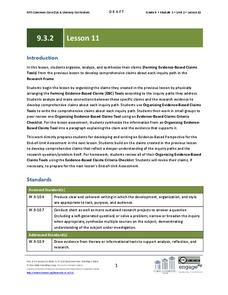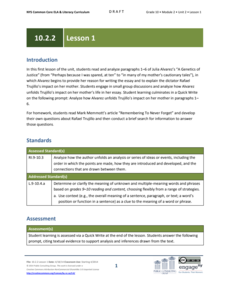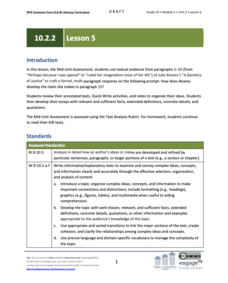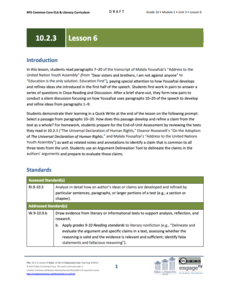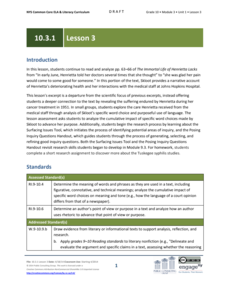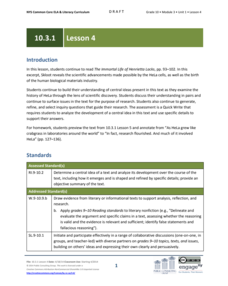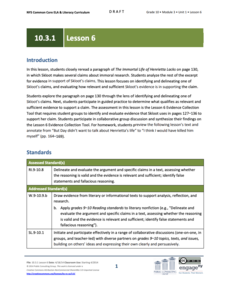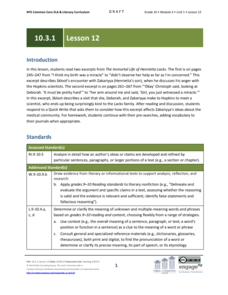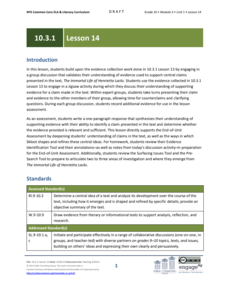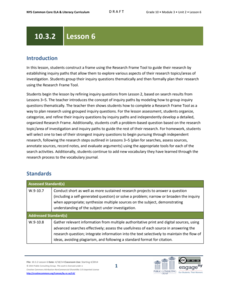EngageNY
Grade 9 ELA Module 2: Unit 1, Lesson 7
Listen to the low, stifled sound that arises from the souls of your ninth graders when overcharged with awe. Inspire them with a captivating instructional activity about "The Tell-Tale Heart." Learners analyze how Poe uses the story...
EngageNY
Grade 9 ELA Module 2, Unit 2, Lesson 18
The punishment must fit the crime, even for a king. Sophocles' Oedipus the King meets its grisly end with a lesson that focuses on the conclusion of the play and Oedipus' self-assigned punishment. Learners connect the symbolism of his...
EngageNY
Grade 9 ELA Module 2, Unit 2, Lesson 19
Now that readers can see the full scope of Sophocles' Oedipus the King, they can draw connections between the dramatic ending and the textual evidence throughout the Greek tragedy. As they prepare for the unit assessment writing prompt,...
EngageNY
Grade 9 ELA Module 3, Unit 2, Lesson 6
Having formulated a list of inquiry questions based on a reading of Temple Grandin's Animals in Translation, high schoolers complete a frame tool for their research. They categorize their questions based on preliminary research and trace...
EngageNY
Grade 9 ELA Module 3, Unit 2, Lesson 10
Ninth graders continue their inquiry-based research projects focused on the topics in Temple Grandin's Animals in Translation. After formulating, honing, and adapting their research frames in the previous lessons, learners select...
EngageNY
Grade 9 ELA Module 3, Unit 2, Lesson 11
Asking questions often leads to more questions. In a research instructional activity based on Temple Grandin's Animals in Translation, ninth graders formulate claims based on the synthesis and analysis of each of their inquiry paths. A...
EngageNY
Grade 9 ELA Module 3, Unit 2, Lesson 12
Ninth graders synthesize their inquiry paths, research process, and claim formulation with a writing assessment at the end of the unit. Learners write a one-page perspective about their conclusions from the research process and outcomes...
EngageNY
Grade 9 ELA Module 4, Unit 1, Lesson 9
The supplemental text, "How Your Addiction to Fast Fashion Kills," allows learners to compare how other writers use evidence to support the argument that "rich countries benefit from harsh and abusive labor practices in poor countries."...
EngageNY
Grade 10 ELA Module 2: Unit 1, Lesson 13
Freedom is not free. Scholars write to a prompt analyzing two pieces of work that develop ideas about freedom. Readers compare “Freedom” by Rabindranath Tagore and "Letter from Birmingham Jail" by Martin Luther King Jr. Learners work...
EngageNY
Grade 10 ELA Module 2: Unit 3, Lesson 3
What is in a word? Scholars look closely at the words from a speech by Eleanor Roosevelt. They analyze how she supports a claim without debate and without rejecting others. Learners use jigsaw discussion, guided questions, and respond to...
EngageNY
Grade 10 ELA Module 2: Unit 2, Lesson 1
Rafael Trujillo was president of the Dominican Republic in the 1930s. Pupils read and analyze the first six paragraphs of Julia Alvarez's autobiographical essay "A Genetics of Justice," in which the author describes Trujillo's impact on...
EngageNY
Grade 10 ELA Module 2: Unit 2, Lesson 5
How do learners use textual evidence from a close reading to write a well-developed essay? Scholars try it by completing a mid-unit assessment based on their analysis of the first 15 paragraphs from "A Genetics of Justice" by Julia...
EngageNY
Grade 10 ELA Module 2: Unit 3, Lesson 6
Let children be children. Scholars read in a speech by Malala Yousafzai how childhood is absent as children are forced to work and get married at a young age. Learners analyze part of the speech and discuss it in groups. After sharing...
EngageNY
Grade 10 ELA Module 3: Unit 1, Lesson 3
Choose your words wisely. Scholars examine word choice in an excerpt from The Immortal Life of Henrietta Lacks. Learners work in pairs and groups to discuss how the author's choice of words creates a deeper connection between the reader...
EngageNY
Grade 10 ELA Module 3: Unit 1, Lesson 2
Is writing a craft? Scholars work in pairs and groups to uncover the author's craft presented in The Immortal Life of Henrietta Lacks. They answer guided questions, discuss with peers, and analyze the series of events. Completing a...
EngageNY
Grade 10 ELA Module 3: Unit 1, Lesson 1
Can people live forever? Scholars ponder the answer as they analyze an excerpt from The Immortal Life of Henrietta Lacks. As readers discover Lacks' immortal cells, they discuss how the author carefully sequences, connects and unfolds...
EngageNY
Grade 10 ELA Module 3: Unit 1, Lesson 4
It's all about the details. Scholars examine how specific details contribute to a central idea in an excerpt from The Immortal Life of Henrietta Lacks. Learners discuss the details in pairs, share with the group, and respond to guided...
EngageNY
Grade 10 ELA Module 3: Unit 1, Lesson 6
Is there an underlying message? After looking at an excerpt from The Immortal Life of Henrietta Lacks, scholars discuss how the author uses words to present a claim. Learners work through an evidence tool and guided questions to support...
EngageNY
Grade 10 ELA Module 3: Unit 1, Lesson 12
First impressions are crucial. Scholars read two excerpts from The Immortal Life of Henrietta Lacks. One describes the family's negative opinion of the hospital, while the other discusses their meeting a very kind doctor. Learners work...
EngageNY
Grade 10 ELA Module 3: Unit 1, Lesson 10
I know exactly how you feel. That may be a statement between Henrietta Lacks and John Moore. Scholars read John Moore's story and compare his story of cell use to that of Henrietta. Learners record in a vocabulary journal, analyze...
EngageNY
Grade 10 ELA Module 3: Unit 1, Lesson 14
Do you have a valid claim? Learners become judges of claims as they expand on evidence collected in lesson 13 and develop claims. They present claims to one another and respond to questions and counterclaims. To finish, individuals...
EngageNY
Grade 10 ELA Module 3: Unit 1, Lesson 15
It's time for the grand finale! Scholars finalize their learning in a two-part end-of-unit assessment. This assessment covers multiple standards as learners demonstrate their understanding of the central idea, comprehension, and...
EngageNY
Grade 10 ELA Module 3: Unit 1, Lesson 9
Scholars examine an excerpt from The Immortal Life of Henrietta Lacks and determine how the author builds up smaller details to create the larger idea of the main passage. To finish the lesson plan, learners discuss in pairs, answer...
EngageNY
Grade 10 ELA Module 3: Unit 2, Lesson 6
Choose your path carefully. When beginning research, learners must figure out which inquiry path to follow. After determining a path, scholars guide their research based on the chosen theme to further refine the questions they...







